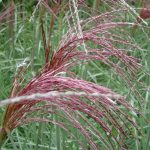Ornamental grasses with Monica Lucas
Posted:10 March 2010
“Rushes are round, sedges have edges, and grasses are glorious”. So said expert grower Monica Lewis at last Saturday’s Garden House workshop!
Enthusiastic and hugely knowledgeable, Monica talked the group through the seemingly endless and largely irresistible variations. So, why grasses?
 Grasses are versatile, an almost essential component in any modern planting scheme. They rustle delicately in the wind (the larger the leaf the more noise they make) and change colour according to season, light levels, sun and shade, rain or frost. They can be used as hedging, as low-level edging for pathways or beds they can be planted as ribbons through beds to give visual continuity, or used to create a stunning backdrop for contrasting perennial planting. Some are evergreen, some deciduous. Many grow well in containers.
Grasses are versatile, an almost essential component in any modern planting scheme. They rustle delicately in the wind (the larger the leaf the more noise they make) and change colour according to season, light levels, sun and shade, rain or frost. They can be used as hedging, as low-level edging for pathways or beds they can be planted as ribbons through beds to give visual continuity, or used to create a stunning backdrop for contrasting perennial planting. Some are evergreen, some deciduous. Many grow well in containers.
There are also annual grasses, easily grown from seed, which mix beautifully with hardy annuals in the cutting garden.
The last ten years has seen grasses return to fashion in a big way. Naturalistic prairie-style planting developed in Germany, Holland (think Piet Oudolf) and North America sees blocks of tall grasses and statuesque perennials mingled together to form flowing borders of late-flowering colour.
To see this style of planting at close-hand, visit the stunning 6-acre Sussex Prairie garden near Henfield, Sussex (featured on this website 24.11.2009). Here the large borders, planted by owners Paul and Pauline McBride, combine perennials with huge drifts of ornamental grasses, including varieties of Miscanthus, Panicums, Molinias, Sporobolis and Penisetum. For open days check www.sussexprairies.co.uk
Monica Lucas talks about ‘cool growers’ and ‘warm growers’. Cool growers flower in late spring and early summer (propagate in spring and autumn), whilst warm growers flower in summer and autumn, keeping most of their dried flowers all winter until broken down by the weather (propagate in spring and early summer).
In general grasses need a free-draining moisture-retentive soil and whilst there are always exceptions to the ‘rules’, and many other options, Monica suggests the following:
- Koeleria glauca
- Melica ciliata
Grasses for clay:
- Calamagrostis x acutiflora cvs.
- Deschampsia caespitose cvs.
- Elymus glaucus
- Phalaris arundinaria cvs.
- Briza media
- Calamagrostis acutiflora Karl Foerster
- Calamagrostis brachytricha
- Carex (most cultivars)
- Deschampsia caespitose cvs.
- Hackenochloa macra cvs.
- Milium effusem aureum
- Miscanthus sinensis purpureus
- Molinia caerulea (all cultivars)
- Stipa arundinaria
Key learnings from the workshop:
- For long term container planting, use ½ John Innes soil-based potting compost No2, ½ soil-less compost, a good deal of ½” grit for drainage, and a controlled release fertilizer (such as Osmacote).
- Don’t over-feed (they won’t flower well) grasses prefer a low-nitrogen soil – so go easy on the chicken pellets or manure, in preference use well-rotted garden compost.
- If you like a plant, but are unsure if it will grow on your soil, buy three and plant them in various locations in the garden. Wherever they grow best, transfer the others – they will have found their home!
- Propagation involves digging out the plant and setting to (carefully!) with a variety of knives, saws, or even an axe, to cut the root ball into small sections ready to pot up for a few weeks before planting out.
- Use a wide-toothed comb to ‘preen’ (not ‘prune’) evergreen grasses combing out the dead stalks to clear space for new growth.
When pressed Monica told us her personal favourite is Miscanthus Nepalensis common name: Himalayan fairy grass!



